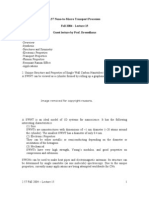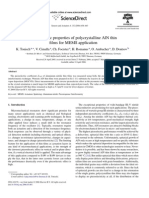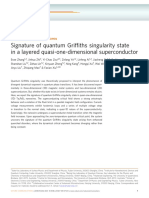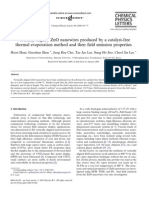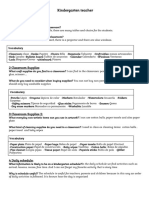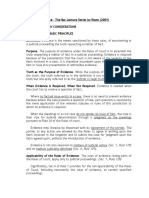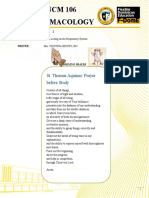Supporting Online Material For: Guided Growth of Millimeter-Long Horizontal Nanowires With Controlled Orientations
Supporting Online Material For: Guided Growth of Millimeter-Long Horizontal Nanowires With Controlled Orientations
Uploaded by
WeiHsinCopyright:
Available Formats
Supporting Online Material For: Guided Growth of Millimeter-Long Horizontal Nanowires With Controlled Orientations
Supporting Online Material For: Guided Growth of Millimeter-Long Horizontal Nanowires With Controlled Orientations
Uploaded by
WeiHsinOriginal Title
Copyright
Available Formats
Share this document
Did you find this document useful?
Is this content inappropriate?
Copyright:
Available Formats
Supporting Online Material For: Guided Growth of Millimeter-Long Horizontal Nanowires With Controlled Orientations
Supporting Online Material For: Guided Growth of Millimeter-Long Horizontal Nanowires With Controlled Orientations
Uploaded by
WeiHsinCopyright:
Available Formats
www.sciencemag.
org/cgi/content/full/333/6045/1003/DC1
Supporting Online Material for
Guided Growth of Millimeter-Long Horizontal Nanowires with Controlled
Orientations
David Tsivion, Mark Schvartzman, Ronit Popovitz-Biro, Palle von Huth, Ernesto Joselevich*
*To whom correspondence should be addressed. E-mail: ernesto.joselevich@weizmann.ac.il
Published 19 August 2011, Science 333, 1003 (2011)
DOI: 10.1126/science.1208455
This PDF file includes:
Materials and Methods
SOM Text
Tables S1 and S2
Figs. S1 to S20
References (3237)
3
1. Materials and Methods
1.1 Substrate preparation
Sapphire (-Al
2
O
3
) wafers with eight different orientations were used. Singular
(i.e., well-cut) sapphire wafers, including C-plane (0001), M-plane ( 0 1 10 ), A-plane
) 0 2 11 ( and R-plane ( 02 1 1 ), were purchased from Roditi International. Miscut C-plane
(0001) sapphire wafers with different miscut directions were custom-produced as
previously described (16,32). The manufacturer (Gavish Ltd., Omer, Israel), produced the
wafers as directed, and the exact miscut tilt and azimuth angles were determined by our
own developed procedure of asymmetric double exposure back-reflection XRD (17).
Miscut C-plane and M-plane sapphire substrates were annealed at 1100 C and 1400 C,
respectively, in air, using a high-temperature muffle furnace (Carbolite RHF 16/8). Prior
to use, the substrates were sonicated for 10 minutes in acetone, then rinsed in acetone,
isopropyl alcohol (IPA), and distilled H
2
O, and blow-dried in N
2
.
1.2 Catalyst deposition and patterning
The Ni catalyst was deposited by electron-beam evaporation of a thin (5-20)
metal layer. First, the areas for catalyst deposition were defined using standard
photolithography with negative or positive photoresists. After pattern development and
surface cleaning by oxygen plasma (March Plasmod GCM 200, 2 min, 1 sccm of O
2
, 100
W) thin films (5-20 ) of Ni was deposited by electron-beam evaporation. These thin Ni
films undergo dewetting upon heating, thus generating the nanoparticles that serve as
catalyst for the VLS growth of nanowires (Fig. S18-20). We also performed experiments
using Ni, Fe and Au catalysts from colloidal suspensions and salts, obtaining similar
4
results. However, all the results presented in this report were performed with evaporated
Ni.
1.3 Nanowire synthesis
Nanowires were grown in a home-built hot-wall CVD with fast heating capability.
The gallium source was Ga
2
O
3
powder placed inside the oven. The nitrogen source is dry
NH
3
(99.999%, Maxima). H
2,
Ar or N
2
are used as carrier gases (all gases 99.999%,
Gordon Gas). In a typical experiment, a sample is placed on a fused-silica carrier plate
and inserted to a 25 mm diameter quartz tube. The tube is inserted into a split oven and
purged of oxygen by 5 cycles of pumping to 10 mbar and purging with N
2
or Ar at
elevated temperature. Once the tube is purged, dry NH
3
(2-30 sccm) and H
2
gas (30-120
sccm) are streamed into the tube, and pressure is maintained between 50 torr to
atmospheric pressure. Once the desired temperature (930-1000 C) is achieved, the oven
is moved over the Ga
2
O
3
powder, and turned off at the end of the growth time (10 min to
8 hours).
1.4 Microscopic characterization
The grown nanowires were characterized using field-emission SEM (Supra 55VP
FEG LEO Zeiss) at low working voltages of 1-5kV. Atomic force microscopy (AFM,
Veeco, Multimode Nanoscope IV). Images were acquired in air tapping mode using 70
kHz (FESP1) and 300 kHz (RTESP7) silicon tips (Nanoprobes).Thin lamellae for TEM
characterization were made using a FEI Helios DualBeam microscope, and inspected
using a FEI Tecnai F30-UT field emission TEM, equipped with a parallel EELS (Gatan
imaging filter) operating at 300 kV. TEM digital images were recorded using a Gatan
Ultrascan1000 CCD camera. TEM images were analyzed to determine crystallographic
5
orientation and epitaxial relationships using Fourier transform (FFT) from selected areas
in the nanowire cross-sections. Indexing of the FFT peaks was done according to
crystallographic tables for bulk GaN, as shown in Fig. S11. Atomic models were verified
with TEM simulations, using EMS software (33) for nanowires grown on C, A, and M-
plane sapphire.
1.5 Optical characterization
Photoluminescence spectra from single GaN nanowires were acquired with a Jobin-
Yvon LabRam HR 800 micro-Raman system, equipped with a liquid-N
2
-cooled detector.
For the excitation, we used a He-Cd laser at 325 nm. The laser power on the sample was
5 mW. The measurements were taken with a 2400 g mm
-1
grating for the UV (spectral
resolution 4 cm
-1
) and a confocal microscope with a 100 m aperture and a 10 m laser
spot. Care was taken to measure spectra from isolated nanowires. Photoluminescence
spectra were measured up to 730 nm for (i) horizontally grown nanowires on C(0001),
R( 02 1 1 ), M( 0 1 10 ), annealed M( 0 1 10 ) and miscut C(0001) toward ] 0 1 10 [ , (ii)
nanowires vertically grown as forests under the same conditions as (i) and dispersed on
A( 0 2 11 ) sapphire. Spectra from more than 20 single nanowires were measured, yielding
quite similar results. No yellow photoluminescence was observed in any of the
nanowires. Occasionally, a few nanowires, both horizontally and vertically grown,
displayed a small shoulder around 420 nm. No other peaks were observed at longer
wavelengths up to 730 nm.
6
3.6 Electrical characterization
GaN nanowire field effect transistors (FETs) were fabricated by defining source
and drain electrodes using electron-beam lithography (JEOL 6400 SEM equipped with
JC Nabity Nanopattern Generator System), followed by electron-beam evaporation of Ti
(20 nm) and Au (30 nm) (34), and liftoff in acetone. Rapid thermal annealing (500
o
C,
3min) was done to ensure low-resistance ohmic characteristics of the fabricated contacts.
The typical electrodes were of 2 m width, separated by 2-5m from each other. For
gate dielectric, 400 nm thick SiO
2
was deposited by plasma enhanced chemical vapor
deposition (PECVD, Nextral 890). A top-gate electrode was patterned by electron-beam
lithography, electron-beam evaporation (Cr 5 nm/Au 50 nm) and liftoff.
Two-terminal electrical characterizations were done by applying source-drain DC
bias, and measuring I-V curves as a function of gate voltage. To characterize the possible
influence of the contact resistance on our measurements, two additional external
electrodes were added to allow 4 point resistance measurement, giving the value of 183
kO vs. 197 kO obtained by direct two point measurement. The slight difference between
the two values should be attributed to the contact resistance, which was found to be two
orders of magnitude lower than that of the characterized nanowires, and can then be
neglected.
The charge carrier mobility () was extracted from the transconductance g
m
, which
is defined as the slope of I
sd
-V
g
curve in the linear region and is given by equation (S2),
where V
g
is the gate voltage, I
dc
is the mobility, L is the nanowire channel length, and C is
the capacitance (35). The capacitance is calculated using quasi-circular cross-section
approximation given by equation (S3), where h is the dielectric thickness and a is the
7
width of the horizontal GaN nanowire (36). The carrier concentration n
e
was extracted
from the threshold voltage V
th
using equation (S4), where r is the nanowire radius and the
total charge Q =
th
CV .
Overall, about 20 nanowire transistors with channel lengths in the range of 3-5
m were fabricated and characterized, giving the mobility values ranging from 60 cm/V
.
s
to 250 cm/V
.
s, and the carrier density values ranging from 1x10
18
cm
-3
to 2x10
19
cm
-3
.
sd
const V
g
dc
m
V
L
C
dV
dI
g
sd
) (
2
.
= =
=
(S2)
) / 4 ln(
2
0
a h
L
C
tcc
~
(S3)
L r e n CV Q
e th
2
t = =
(S4)
2. Further discussion on the guided growth mechanism
As mentioned in the main text, the mechanism of guided growth is not yet fully
understood. Ref (31) presents a model that could be relevant to our results. However, as a
continuum model, it does not refer to the epitaxial relationship between the nanowire
material and the substrate. To explain and predict the orientation control in our results, a
more detailed model, beyond the scope of this Report, will be required. To this end, a few
important observations need to be taken into account. First, the epitaxial relationships of
most of our nanowires are consistent with those reported in literature for thin films
produced by different methods (22). This suggests a significant degree of thermodynamic
control. On the other hand, the most common facets observed in our nanowires are not
necessarily the most thermodynamically stable ones. For instance, the { 2 2 11 } facets,
which are quite common in our results (Fig. S1 and Table S1), are not part of the
equilibrium Wulff shape of GaN, but are known as fast-growing planes in the kinetic
8
Wulff plot (37). This indicates a significant degree of kinetic control. Moreover, in terms
of symmetry, the unidirectional growth of nanowires with nonpolar orientations on the R
and M planes of sapphire cannot be explained by the thermodynamics of the nanowire-
substrate interaction alone, so it is clear that kinetics and the catalysts play a major role in
the mechanism of guided VLS growth. This also suggests that by changing the growth
conditions, the orientation control could be further improved.
The mechanism of termination of nanowire growth is also yet to be understood. We
may speculate that growth termination can be caused by pinning or poisoning of the
catalysts by defects or impurities on the substrate. Since we pattern the catalyst in stripes
and the nanowires grow onto the clean sapphire areas (Figs. S18-S20), a nanowire can
grow very long before the catalyst gets pinned or poisoned. The guided growth of the
nanowire should exert on the catalyst a large and highly anisotropic force, which can
overcome pinning forces, thus allowing the nanowire to keep growing for very large
distances exceeding 1 mm. The force exerted on the catalyst by graphoepitaxial growth
on a faceted surface is probably more highly anisotropic than that exerted by epitaxial
growth on an atomically flat surface. This could explain why graphoepitaxial nanowires
are generally better aligned than epitaxial nanowires.
9
3. Complete Nanowire Characterization
10
Fig. S1. Growth directions, crystallographic orientations and faceting of horizontally
grown GaN nanowires on different sapphire substrates. The growth directions are
schematically represented in relation with the morphological symmetry of the substrate.
The SEM images show the observed growth direction from patterned catalyst islands.
The cross-sectional TEM images show the most common epitaxial relationship,
crystallographic orientation, faceting and size of the GaN nanowires for each sapphire
plane. The model is based on these observations. Comprehensive data are shown in Table
S1 and Figs. S2-S16.
11
Table S1. Comprehensive crystallographic data for horizontally grown GaN nanowires.
Nanowire axial orientations are highlighted in yellow.
*
These nanowires have the same crystallographic axis orientation as the previous case, but are rotated with respect
to their axis.
These nanowires have all the same crystallographic axis orientation, but are rotated with different rotations with
respect to their axis.
XXXX indicates variable directions or planes.
Some of these nanowires have the same crystallographic axis orientation, but are rotated with different rotations
with respect to their axis.
UUUU Indicates undefined planes.
Substrate
Orientation
#of
wires
Epitaxialrelationship Nanowirefacets
Horizontal
GaNAl
2
O
3
Axial
GaNAl
2
O
3
Transversal
GaNAl
2
O
3
C (uuu1) 9 (uuu1)(uuu1) |1u1
u]|112
u] |12
1u]|11
uu] (12
12),(uuu1
),(12
12
)
A (112
u) 7 (uuu1)(112
u) |1u1
u]|1u1
u] |12
1u]|uuu1] (12
12),(uuu1
),(12
12
)
R (11
u2)
1u ( 12
16
)(11
u2) |1u1
u]|1
1u1] |12
12]|1
2u] (12
12),(uuu1
),(12
12
)
8
*
(uuu1)(11
u2) |1u1
u]|1
1u1] |12
1u]|1
2u] (12
12),(uuu1
),(12
12
)
2 (S2
u)(11
u2) |14S
S]|1
1u1] |1u1
S]|1
2u] (1
u12),(u1
1S)
N (1u1
u)
1S (11
uS)(1u1
u) |112
u]|uuu1
] |1
1u1]|12
1u] (uuu1
),(1
1u1)
S
*
(11
uu)(1u1
u) |112
u]|uuu1
] |uuu1]|12
1u] (uuu1
),(11
u1)
4 (S2
u)(1u1
u) |14S
S]|uuu1
] |1u1
S]|12
1u] (1
u12),(u1
1S)
S (112
2)(1u1
u) |112
]|uuu1
] |11
uu]|12
1u] (u11
1),(112
2),(1u1
1)
Annealeu N
(1u1
u)
9
(XXXX)
(1u1
u) |14S
S]|12
1u] |XXXX]
|uuu1] (1
u12),(11
u1)
1 (1u1
u)(1u1
u) |uuu1]|12
1u] |12
1u]|uuu1] (u11
u),(1u1
u),(11
uu)
1 (12
12)(1u1
u) |1u1
u]|12
1u] |1
21
S]|uuu1] (uuu1
),(uuu1),(12
12)
Annealeu C
(uuu1) miscut
towaiu |11
uu]
4
(11
u1)(uuu1) |14S
S]|112
u] |1
u12]|11
uu] (1
u12),(11
u1)
1 (uuu1)(uuu1) |112
u]|112
u] |1u1
u]|11
uu] (11
u2
),(uuu1
),(11
u2)
Annealeu C
(uuu1) miscut
towaiu |1
1uu]
4
(11
u1)(uuu1) |14S
S]|112
u] |1
u12]|11
uu] (1
u12),(11
u1)
Annealeu C
(uuu1) miscut
towaiu |112
u]
S (1
1u1)(uuu1) |11
u2]|11
uu] |112
u]|112
u] (S
122),(1
S2
2),(1
1u1)
2 (uuu1) (1
21
4) |224
]|11
uu] |1u1
u] |112
u] (112
2),(S
122)
1 (u11
)(uuu1) |1
2S]|11
uu] |112
u] |S1
1] (1u1
u),(0000)
12
Table S2. Mismatch between GaN and Al
2
O
3
along and across the nanowires
o
a : bulk lattice parameter
The mismatch is calculated using equation (S1), where a
0
is the lattice spacing for the
substrate and the nanowire in the relevant direction. The mismatch is calculated for 1:1
ratio, and also for other ratios, where such a ratio improves the matching. The table
shows no clear trend favoring a lower mismatch along than across the nanowire.
Therefore, we are not able to claim that strain minimization along the nanowire is the
major factor determining the growth direction. It is thus likely that other factors, such as
the kinetics of nanowire growth could also play a role in determining the growth
directions.
) (
) ( ) (
3 2
3 2
O Al a
GaN a O Al a
mismatch
o
o o
=
(S1)
Epitaxy
GaNAl
2
O
3
Longitudinal Transversal
o
a ()
GaN : Al
2
O
3
Ratio
GaN : Al
2
O
3
Mismatch
o
a ()
GaN : Al
2
O
3
Ratio
GaN : Al
2
O
3
Mismatch
(uuu1)(uuu1)
2.762 : 2.380 1 : 1 -0.16 1.595 : 4.123 1 : 1 0.60322
7.975 : 8.246 5 : 2 0.033
(uuu1)(112
u)
2.762 : 4.123 1 : 1 0.33 1.595 : 2.165 1 : 1 0.263
8.286 : 8.246 3 : 2 -0.0048 7.975 : 8.660 5 : 4 0.079
(uuu1)(11
u2)
2.762 : 5.189 1 : 1 0.461 1.595 : 2.380 1 : 1 0.330
5.524 : 5.189 2 : 1 -0.077 4.785 : 4.760 3 : 2 -0.0049
(11
uu)(1u1
u)
1.595 : 2.165 1 : 1 0.263 2.594 : 2.380 1 : 1 -0.0897
6.380 : 6.495 4 : 3 0.018
13
Fig. S2. Cross-sectional TEM of GaN nanowires on C(0001) sapphire. All the nanowires
have the same orientation and the same epitaxial relationship with the substrate, as
summarized in Table S1.
14
Fig. S3. Side-view TEM of a GaN nanowire on C(0001) sapphire. The epitaxial
relationships are in agreement with the cross-sectional TEM images (Fig. S1).
15
Fig. S4. EELS elemental map of GaN on C-plane sapphire (left: Al and Ga, right: N and
O). No interdiffusion between nanowire and substrate is observed.
16
Fig. S5. Cross-sectional TEM of GaN nanowires on A ) 0 2 11 ( sapphire. All the
nanowires have the same orientation and the same epitaxial relation with the substrate, as
summarized in Table S1.
17
Fig. S6. Cross-sectional TEM of GaN nanowires on R ) 02 1 1 ( sapphire. The vast
majority of nanowires grow along their [ 0 1 10 ]
GaN
direction. In about half of these
18
nanowires, the (0001)
GaN
plane is parallel to the substrate, as the nanowire shown in Fig.
2A. The other wires have similar axis orientation, but are rotated by 30 with respect to
their axis, such that their ( 6 1 2 1 )
GaN
plane is parallel to the substrate. The facets are
always ( 12 2 1 ), ( 2 1 2 1 ) anu ( 1 000 ). The nanowire growth axis is usually [ 0 1 10 ]
GaN
,
but sometime it can slightly deviate toward the [ 1 20 2 ] direction. This small deviation is
within the range of sample alignment at the TEM. An additional nanowire, growing along
the [ 3 5 14 ]
GaN
orientation is also shown, but this orientation was only seen twice, on non-
flat regions of the substrate. Orientations and epitaxial relationships are summarized in
Table S1.
19
Fig. S7. Cross-sectional TEM of GaN nanowires on M( 0 1 10 ) sapphire having a
| 0 2 11 ]
GaN
axis, and a ( 03 1 1 )
GaN
( 0 1 10 )
Al20S
interface, as summarized in Table S1.
20
Fig. S8 Cross-sectional TEM of GaN nanowires on M( 0 1 10 ) sapphire, having a
| 0 2 11 ]
GaN
axis, and a ( 00 1 1 )
GaN
( 0 1 10 )
Al20S
interface, as summarized in Table S1.
Fig. S9. Cross-sectional TEM of GaN nanowires on M(101
0) sapphire having a |14S
S].
axis, as summarized in Table S1.
21
Fig. S10. Cross-sectional TEM of GaN nanowires on M(1u1
u) sapphire having a |112
]
axis, as the nanowire shown in Fig 2B, and summarized in Table S1.
Fig. S11. Explanation of the variation in the rotation position of GaN nanowires on M-
plane sapphire, based on symmetry of the substrate material. The nanowire growth on M
plane (1u1
u) sapphire can be divided into 3 families, according to the growth axis: (i)
] 0 2 11 [ (by far, the most common), (ii) ] 3 2 11 [ , and (iii) |14S
S]. However, due to the
symmetry of the substrate in the nanowire growth direction, the nanowires that grow
along the ] 0 2 11 [
GaN
can be found in 3 orientations, rotated by 60 around the nanowire
22
axis. This is demonstrated in this figure, where the GaN (0001) planes can match the
Al
2
O
3
(112
u) planes in three ways: (A) The GaN ) 0001 ( planes match the sapphire
) 0 2 11 ( planes. (B) The GaN ) 0001 ( planes match the sapphire ) 10 2 1 ( planes. (C) The
GaN ) 0001 ( planes are aligned with the sapphire ) 110 2 (
planes.
23
Fig. S12. Cross-sectional TEM of GaN nanowires on annealed M(1u1
u) sapphire. Three
such types of nanowires, labeled A, B and C can be identified, as summarized in table S1.
The nanowires with the most common orientation, labeled A, share a common grow axis.
24
However, these nanowires can be rotated in different angles with respect to their growth
axis, so they have different epitaxial relationships with the substrate. This could be due to
the competition between the interfaces of the GaN with the R(11
02) and S(11
01
) planes
of the sapphire simultaneously, where each plane has its own preferred orientation.
25
Fig. S13. Analysis of cross-sectional TEM images and identification of crystallographic
nanowire orientation, exemplified for two different GaN nanowires grown on annealed
M-plane sapphire. (A) TEM image. (B) Fourier transform (FFT) from a selected area in
26
the nanowire cross-section. Indexing of the FFT peaks is done according to
crystallographic tables for bulk GaN. The nanowire axis corresponds to the zone axis,
namely the cross product of the first linearly independent indices, (1
u12) (11
u1) =
|14S
S]. (C) Simulated electron diffraction pattern for the latter crystallographic
orientation, including d-spacings and o = 87.7, for comparison with the FFT (B). Here,
the R(1
u12) planes of GaN nanowire are aligned with the R(11
u2) planes of the
sapphire substrate. The second nanowire (D-F) has the same axial
orientation along |14S
S], but is rotated around its axis with respect to that of the first
nanowire (A-C), so that the S(11
u1) planes of the GaN are roughly aligned with the
C(0001) planes of the sapphire. It is interesting to note that on the non-annealed M-plane
sapphire the GaN usually grow along their own |112
u]
direction, which is also an
intersection between R and S planes of GaN, although different from those whose
intersection defines the |14S
S] direction.
27
Fig. S14. Cross-sectional TEM of GaN nanowires on annealed vicinal miscut C(0001)
sapphire 2 toward ] 00 1 1 [ . Two types of such nanowires, labeled A and B can be
identified, as summarized in table S1.
28
Fig. S15. Cross-sectional of GaN nanowires on annealed miscut C(0001) sapphire 2
toward ] 100 1 [ . All wires have the same orientation and the same epitaxial relationships
with the substrate, as summarized in table S1.
29
Fig. S16. Cross-sectional TEM of GaN nanowires on annealed miscut C(0001) sapphire
miscut 2 toward ] 0 2 11 [ . Three types of nanowires, labeled A, B and C, can be
identified, as summarized in table S1.
30
Fig. S17. Demonstration of a thin-film transistor (TFT) built on an array of perfectly
aligned horizontal GaN nanowires. (A) Schematic of the device. (B) SEM image (before
31
deposition of the top gate). (C) I-V characteristics of the device for different gate
voltages. The device comprises ca. 40 nanowires spread across a width of 40 m, with
common source and drain electrodes separated by 5 m, and a top gate over a thin (400
nm) SiO
2
film. The transconductance at V
sd
=1.0 V
is g
m
= 4.5x10
-7
-1
, corresponding to
an electron mobility = 246 cm
2
/Vs per nanowire, in consistency with our single-
nanowire FET measurements.
32
Fig. S18. SEM images showing a catalyst nanoparticle (top) at the end of each epitaxial
GaN nanowire horizontally grown on R-plane sapphire from Ni islands (bottom).
33
Fig. S19. SEM images showing a catalyst nanoparticle (bottom) at the end of each
graphoepitaxial GaN nanowire horizontally grown on annealed M-plane sapphire from Ni
islands (top). The substrate nanogrooves are visible in the bottom images.
34
Fig. S20. SEM images showing catalyst nanoparticles at the ends of many
graphoepitaxial GaN nanowires horizontally grown on annealed M-plane sapphire from
Ni islands (bottom) after a short period of time, prior to removal of the vertically grown
nanowires. Each of the 17 nanowires visible in the bottom image shows a catalyst
nanoparticle at its end. The substrate nanogrooves are visible in the bottom images.
35
4. References
32. A. Ismach, E. Joselevich, Nano Lett. 6, 1706 (2006).
33. P.A. Stadelmann, Ultramicroscopy 21, 131 (1987).
34. J. S. Hwang et al., Appl. Phys. Lett. 85, 1636 (2004).
35. R. Martel, T. Schmidt, H. R. Shea, T. Hertel, P. Avouris, Appl. Phys. Lett. 73,
2447 (1998).
36. Y. Cui, X. Duan, J. Hu, C. M. Lieber, J. Phys.Chem. B 104, 5213 (2000).
37. V. Jindal, F. Shahedipour-Sandvik, J. Appl. Phys. 106, (2009).
You might also like
- The Power of Black Music - Interpreting Its History From Africa To The United States (PDFDrive)Document329 pagesThe Power of Black Music - Interpreting Its History From Africa To The United States (PDFDrive)Itz Yuh Anthony100% (3)
- My Good Habits - Welcome Booklet 2 - 1Document17 pagesMy Good Habits - Welcome Booklet 2 - 1lisa_ernsbergerNo ratings yet
- Four-Point TLM Measurement For Specific Contact Resistance AssessmentDocument2 pagesFour-Point TLM Measurement For Specific Contact Resistance AssessmentWeiHsinNo ratings yet
- Resoltution No (LNK) 1Document2 pagesResoltution No (LNK) 1Ja Son TonogbanuaNo ratings yet
- Fowler Nordheim Tunneling in Thin SiO2 FilmsDocument7 pagesFowler Nordheim Tunneling in Thin SiO2 FilmskobelkNo ratings yet
- 1996 AllOpticalSwitchingLN Stegenab OptLetDocument3 pages1996 AllOpticalSwitchingLN Stegenab OptLetsilviutpNo ratings yet
- Conductometric Chemical Sensor Based On Individual Cuo NanowiresDocument7 pagesConductometric Chemical Sensor Based On Individual Cuo NanowiresmirelamanteamirelaNo ratings yet
- Investigations of Microstructures and Defect Structures in Wear A Ected Region Created On Niomonic 80A During High Temperature WearDocument10 pagesInvestigations of Microstructures and Defect Structures in Wear A Ected Region Created On Niomonic 80A During High Temperature WearFathia AlkelaeNo ratings yet
- 2.57 Nano-to-Macro Transport Processes Fall 2004 - Lecture 15 Guest Lecture by Prof. DresselhausDocument10 pages2.57 Nano-to-Macro Transport Processes Fall 2004 - Lecture 15 Guest Lecture by Prof. DresselhauscaptainhassNo ratings yet
- Characteristics of Surface Acoustic Waves in (100) AlN/64oYX-LiNbO3 StructuresDocument7 pagesCharacteristics of Surface Acoustic Waves in (100) AlN/64oYX-LiNbO3 StructuresSEP-PublisherNo ratings yet
- Investigation of Strain Effect in Ingan/Gan Multi-Quantum WellsDocument5 pagesInvestigation of Strain Effect in Ingan/Gan Multi-Quantum WellsA Mohan BabuNo ratings yet
- Thermal Annealing Behaviour of Ni/Au On N-Gan Schottky ContactsDocument5 pagesThermal Annealing Behaviour of Ni/Au On N-Gan Schottky Contactsforio_23No ratings yet
- Cristian Pavéz Et Al - Progress in Z-Pinch Research Driven by The Megaampere Device SPEED2Document5 pagesCristian Pavéz Et Al - Progress in Z-Pinch Research Driven by The Megaampere Device SPEED2Imsaa4No ratings yet
- Experimental Determination of The Principal Dielectric Functions in Silver Nanowire MetamaterialsDocument4 pagesExperimental Determination of The Principal Dielectric Functions in Silver Nanowire MetamaterialsMuhammad YunusNo ratings yet
- Exploring The Peierls-Distorted Vanadium Sulphide As A Rechargeable Mg-Ion Cathod PDFDocument72 pagesExploring The Peierls-Distorted Vanadium Sulphide As A Rechargeable Mg-Ion Cathod PDFFranciscoNo ratings yet
- Chatelaine, Aug 2011Document5 pagesChatelaine, Aug 2011emediageNo ratings yet
- The Role of Substrate Temperatures On Photoconductivity For Insb FilmsDocument5 pagesThe Role of Substrate Temperatures On Photoconductivity For Insb FilmsInternational Journal of Application or Innovation in Engineering & ManagementNo ratings yet
- Advanced Materials - 2023 - Zhao - A Heteroanionic Zinc Ion Conductor For Dendrite Free ZN Metal Anodes-SuppmatDocument31 pagesAdvanced Materials - 2023 - Zhao - A Heteroanionic Zinc Ion Conductor For Dendrite Free ZN Metal Anodes-SuppmatattackonzhangNo ratings yet
- The Effect of Substrate Temperature On Filtered Vacuum Arc Deposited Zinc Oxide and Tin Oxide Thin FilmsDocument9 pagesThe Effect of Substrate Temperature On Filtered Vacuum Arc Deposited Zinc Oxide and Tin Oxide Thin FilmsAlev KızılbulutNo ratings yet
- Thin Solid FilmsDocument6 pagesThin Solid FilmsBhabani Sankar SwainNo ratings yet
- Piezoelectric Properties of AlnDocument6 pagesPiezoelectric Properties of AlnErnest Ting-Ta YenNo ratings yet
- 1 PDFDocument4 pages1 PDFRobby KephiNo ratings yet
- znse Single Crystals: Rapid CommunicationDocument3 pagesznse Single Crystals: Rapid CommunicationAlexanderNo ratings yet
- Study of Ni Fe /alq /ni Fe Nanoscale Junction Devices Utilizing Thin-Film EdgesDocument3 pagesStudy of Ni Fe /alq /ni Fe Nanoscale Junction Devices Utilizing Thin-Film EdgesRobin Red MsiskaNo ratings yet
- AI-APL#241143 FinalDocument16 pagesAI-APL#241143 FinalAnonymous UJFK2jk5gNo ratings yet
- Supporting Information High Energy Output Nanogenerator Based On Reduced Graphene OxideDocument5 pagesSupporting Information High Energy Output Nanogenerator Based On Reduced Graphene OxideFamiloni LayoNo ratings yet
- Coherent Control of Single Spins in Silicon Carbide at Room TemperatureDocument36 pagesCoherent Control of Single Spins in Silicon Carbide at Room TemperatureManjeet BhatiaNo ratings yet
- 2020 Springer - Infuence of Chamber Design On The Gas Sensing Performance of GFET - 2020Document11 pages2020 Springer - Infuence of Chamber Design On The Gas Sensing Performance of GFET - 2020rm5kqjtbwpNo ratings yet
- Chatelaine, May 2011Document3 pagesChatelaine, May 2011emediageNo ratings yet
- Ref 1Document6 pagesRef 1Aashish SinghalNo ratings yet
- Ai Apl#241143Document15 pagesAi Apl#241143Anonymous UJFK2jk5gNo ratings yet
- Simon C. Bott Et Al - Quantitative Measurements of Wire Ablation in Tungsten X-Pinches at 80 KaDocument6 pagesSimon C. Bott Et Al - Quantitative Measurements of Wire Ablation in Tungsten X-Pinches at 80 KaCola7890No ratings yet
- 3m-Nano 2017 8286340Document4 pages3m-Nano 2017 8286340GoxseNo ratings yet
- Sdarticle 2Document4 pagesSdarticle 2Sadaf ZiaNo ratings yet
- Phys Status Solidi B 2010 BansmannDocument9 pagesPhys Status Solidi B 2010 BansmannIDhil AndiNo ratings yet
- Estupiñán2009 Article StoichiometryAnalysisOfTitaniuDocument5 pagesEstupiñán2009 Article StoichiometryAnalysisOfTitaniuSandra Liliana HerreraNo ratings yet
- X-Ray and VUV Spectra From The Laser Plasma Produced With "Kanal-2" FacilityDocument6 pagesX-Ray and VUV Spectra From The Laser Plasma Produced With "Kanal-2" FacilitytsrifNo ratings yet
- Flash Evaporation1Document11 pagesFlash Evaporation1Sudha AsNo ratings yet
- Supporting InformationDocument15 pagesSupporting InformationAbhijeet MohantaNo ratings yet
- Far-Infrared Spectrally Selective LiTaO3 and A1N Pyroelectric Detectors Using Resonant Subwavelength Metal Surface StructuresDocument8 pagesFar-Infrared Spectrally Selective LiTaO3 and A1N Pyroelectric Detectors Using Resonant Subwavelength Metal Surface Structuresppc.sodeporeNo ratings yet
- PZT/P (Vdf-Trfe) Nanocomposites For Ultrasonic Hydrophone ApplicationDocument4 pagesPZT/P (Vdf-Trfe) Nanocomposites For Ultrasonic Hydrophone ApplicationBilal FakharNo ratings yet
- 1 PDFDocument9 pages1 PDFYuan SuiNo ratings yet
- Adfm202400008 Sup 0001 SuppmatDocument14 pagesAdfm202400008 Sup 0001 Suppmatsglee2135No ratings yet
- 1556-276X-9-695Document5 pages1556-276X-9-695imanjebeliniaNo ratings yet
- Correlation Between Dislocations and Leakage Current of P-N Diodes On A Free-Standing Gan SubstrateDocument5 pagesCorrelation Between Dislocations and Leakage Current of P-N Diodes On A Free-Standing Gan SubstrateAna-Maria DucuNo ratings yet
- Slimming World, May 2011Document4 pagesSlimming World, May 2011emediageNo ratings yet
- Vertically Aligned Zno Nanowires Produced by A Catalyst-Free Thermal Evaporation Method and Their Field Emission PropertiesDocument5 pagesVertically Aligned Zno Nanowires Produced by A Catalyst-Free Thermal Evaporation Method and Their Field Emission PropertiescharthanNo ratings yet
- 10.1007-BF02872196 Propiedades ElectricasDocument7 pages10.1007-BF02872196 Propiedades ElectricasGisela BriseñoNo ratings yet
- 2018 Direct Observation of The Domain Kinetics During Polarization Reversal of Tetragonal PMN PTDocument6 pages2018 Direct Observation of The Domain Kinetics During Polarization Reversal of Tetragonal PMN PTAnaghaNo ratings yet
- NANV02I123P0019Document5 pagesNANV02I123P0019nano_journalNo ratings yet
- PRJ 12 1 51Document10 pagesPRJ 12 1 51DevanshNo ratings yet
- Ijaret: ©iaemeDocument9 pagesIjaret: ©iaemeIAEME PublicationNo ratings yet
- Monolayer WS: Crossed With An Electro-Spun PEDOT-PSS Nano-Ribbon: Fabricating A Schottky DiodeDocument22 pagesMonolayer WS: Crossed With An Electro-Spun PEDOT-PSS Nano-Ribbon: Fabricating A Schottky DiodeHYDRANo ratings yet
- Electrical Properties of Aluminum ODocument3 pagesElectrical Properties of Aluminum OAbduesslam AlarabyNo ratings yet
- nz4c00207 Si 001Document13 pagesnz4c00207 Si 001francesco.puccinelliNo ratings yet
- BDSDocument7 pagesBDSAkilan TholkappianNo ratings yet
- Thermally-Tuned Silicon Double Ring Resonator For External Cavity Tunable LaserDocument4 pagesThermally-Tuned Silicon Double Ring Resonator For External Cavity Tunable Laserthanh910No ratings yet
- Al-Doped Zno Thin Films by Conductive Atomic Force MicrosDocument7 pagesAl-Doped Zno Thin Films by Conductive Atomic Force MicrosLuis Alejandro Álvarez ZapataNo ratings yet
- Lab Mst613 (Part B)Document10 pagesLab Mst613 (Part B)hyebibieNo ratings yet
- Raman y FotoluminicenciaDocument5 pagesRaman y FotoluminicenciaAndress GuzmanNo ratings yet
- DRM12 (2003) 201Document7 pagesDRM12 (2003) 201Gabriel LazarNo ratings yet
- AI-APL#241143 EditedDocument17 pagesAI-APL#241143 EditedAnonymous UJFK2jk5gNo ratings yet
- Spintronics for Next Generation Innovative DevicesFrom EverandSpintronics for Next Generation Innovative DevicesKatsuaki SatoNo ratings yet
- Semilab ThinFilmPV ApplicationsDocument38 pagesSemilab ThinFilmPV ApplicationsWeiHsinNo ratings yet
- ALD in Semiconductor ProcessingDocument26 pagesALD in Semiconductor ProcessingWeiHsinNo ratings yet
- Catalog - Giga Rear Ag Photovoltaic Metallization PasteDocument2 pagesCatalog - Giga Rear Ag Photovoltaic Metallization PasteWeiHsinNo ratings yet
- Catalog - JR Product Si Solar Cell HandlingDocument8 pagesCatalog - JR Product Si Solar Cell HandlingWeiHsinNo ratings yet
- Transparent Conducting OxideTransparent Conducting OxideDocument10 pagesTransparent Conducting OxideTransparent Conducting OxideWeiHsinNo ratings yet
- Catalog - Enabling Thin Wafers For Today's High Efficiency Silicon Solar CellsDocument7 pagesCatalog - Enabling Thin Wafers For Today's High Efficiency Silicon Solar CellsWeiHsinNo ratings yet
- Ncomms1543 s1Document6 pagesNcomms1543 s1WeiHsinNo ratings yet
- European Patent Specification: Printed by Jouve, 75001 PARIS (FR)Document21 pagesEuropean Patent Specification: Printed by Jouve, 75001 PARIS (FR)WeiHsinNo ratings yet
- Kindergarten Teacher Book 1:: 1 The ClassroomDocument5 pagesKindergarten Teacher Book 1:: 1 The ClassroomTania Ibars SelmaNo ratings yet
- Impact of Service Charges Charged by Public Sector Banks With Special Reference To Coimbatore CityDocument10 pagesImpact of Service Charges Charged by Public Sector Banks With Special Reference To Coimbatore CityThenmozhiNo ratings yet
- Pathognomonic Signs of Communicable Diseases: JJ8009 Health & NutritionDocument2 pagesPathognomonic Signs of Communicable Diseases: JJ8009 Health & NutritionMauliza Resky NisaNo ratings yet
- Discuss W.B Yeats Treatment of Myth and HistoryDocument2 pagesDiscuss W.B Yeats Treatment of Myth and HistorySawera AbdullahNo ratings yet
- Reheating of The Universe As Holographic ThermalizationDocument5 pagesReheating of The Universe As Holographic ThermalizationR DaniNo ratings yet
- Leo Strauss - Plato & Aristophanes (1960)Document264 pagesLeo Strauss - Plato & Aristophanes (1960)Giordano BrunoNo ratings yet
- Grade Level: 4th Approximate Length of Time: 60 Minutes Curriculum Areas: Language Arts and Science Objectives: Language ArtsDocument5 pagesGrade Level: 4th Approximate Length of Time: 60 Minutes Curriculum Areas: Language Arts and Science Objectives: Language Artsapi-507999615No ratings yet
- Summary Precis AbstractDocument17 pagesSummary Precis AbstractReynver LasalaNo ratings yet
- Ethical Business Decisions - The Framework - Darden Ideas To Action PDFDocument14 pagesEthical Business Decisions - The Framework - Darden Ideas To Action PDFNorrinNo ratings yet
- Evidence - The Bar Lecture Series by RianoDocument8 pagesEvidence - The Bar Lecture Series by RianoTristan U. Adviento100% (1)
- Stress - and - Coping - Self - Test FillableDocument2 pagesStress - and - Coping - Self - Test FillableВиктория КарпецNo ratings yet
- Adv. Fin. Acct Test-2Document4 pagesAdv. Fin. Acct Test-2Samuel DebebeNo ratings yet
- A Review by MalathiDocument12 pagesA Review by MalathiSudheer Kumar NadukuditiNo ratings yet
- Keerthi P: Contact: 832-856-2493Document8 pagesKeerthi P: Contact: 832-856-2493phaniNo ratings yet
- English 4am22 2trim1 2Document4 pagesEnglish 4am22 2trim1 2Mouloud RahmaniNo ratings yet
- Scared ParentDocument2 pagesScared ParentADHDESCEST100% (1)
- Rosa Parks Differentiated Reading Comprehension ActivityDocument12 pagesRosa Parks Differentiated Reading Comprehension ActivitylordychancertsieloNo ratings yet
- Dibs in Search of SelfDocument7 pagesDibs in Search of SelfWong Yuet YanNo ratings yet
- Lecture 3 Mean Geometric Mean Harmonic Mean 08032021 044228pmDocument2 pagesLecture 3 Mean Geometric Mean Harmonic Mean 08032021 044228pmHafsa Tanveer100% (1)
- 120 Degree Mode of ConductionDocument5 pages120 Degree Mode of ConductionAyshwar Venkatesh75% (4)
- Understanding SelfDocument22 pagesUnderstanding SelfKim KimNo ratings yet
- Birkett v. Law Society of OntarioDocument6 pagesBirkett v. Law Society of OntarioRounak VirmaniNo ratings yet
- Contemporary Arts WEEK 3 5 CabanesDocument15 pagesContemporary Arts WEEK 3 5 CabanesCHRISTIAN JAMES MANLEGRONo ratings yet
- Gospel Message For YouthDocument3 pagesGospel Message For YouthElizabethNo ratings yet
- A Guide To Catholic BaptismDocument2 pagesA Guide To Catholic Baptismirish x100% (1)
- Plosive Consonant Pronunciation Lesson What S Your Favorite FoodDocument6 pagesPlosive Consonant Pronunciation Lesson What S Your Favorite FoodGabriela CastellinoNo ratings yet
- Ngo (2bsn1) - NCM 106 (Module 2)Document16 pagesNgo (2bsn1) - NCM 106 (Module 2)Amiel simon NgoNo ratings yet








